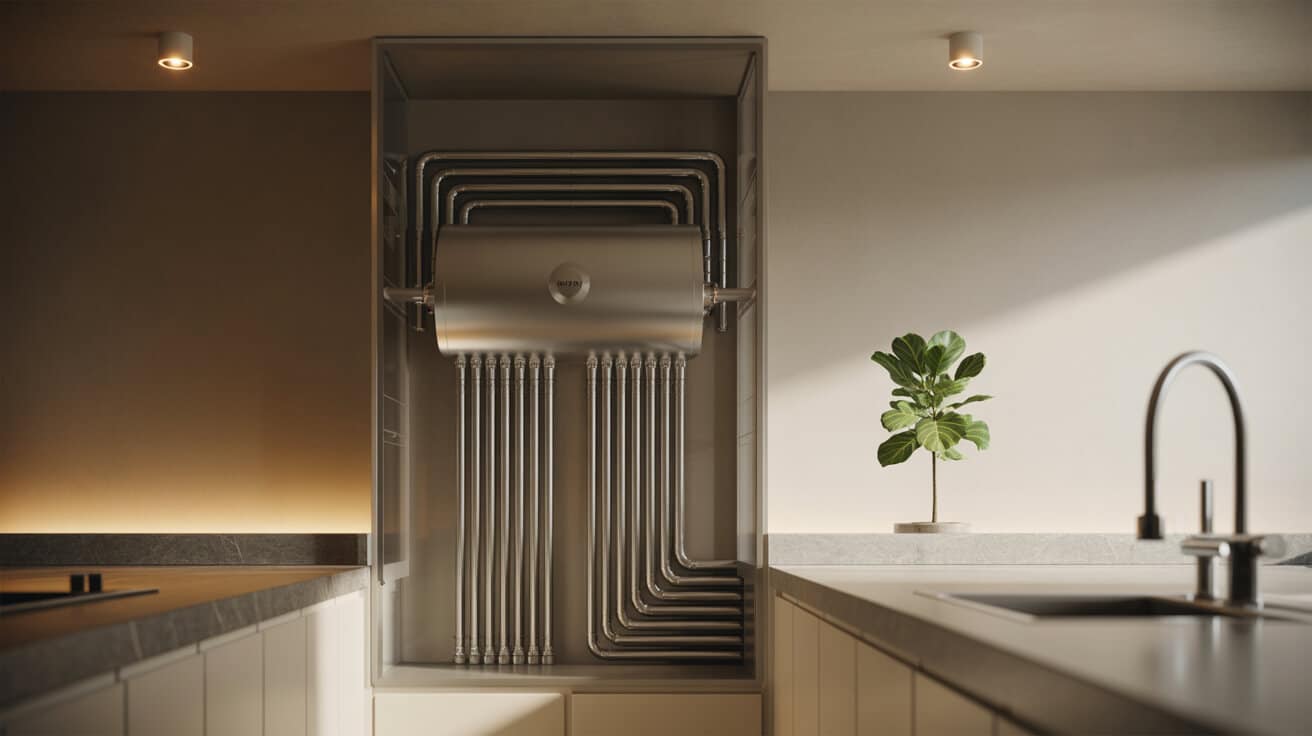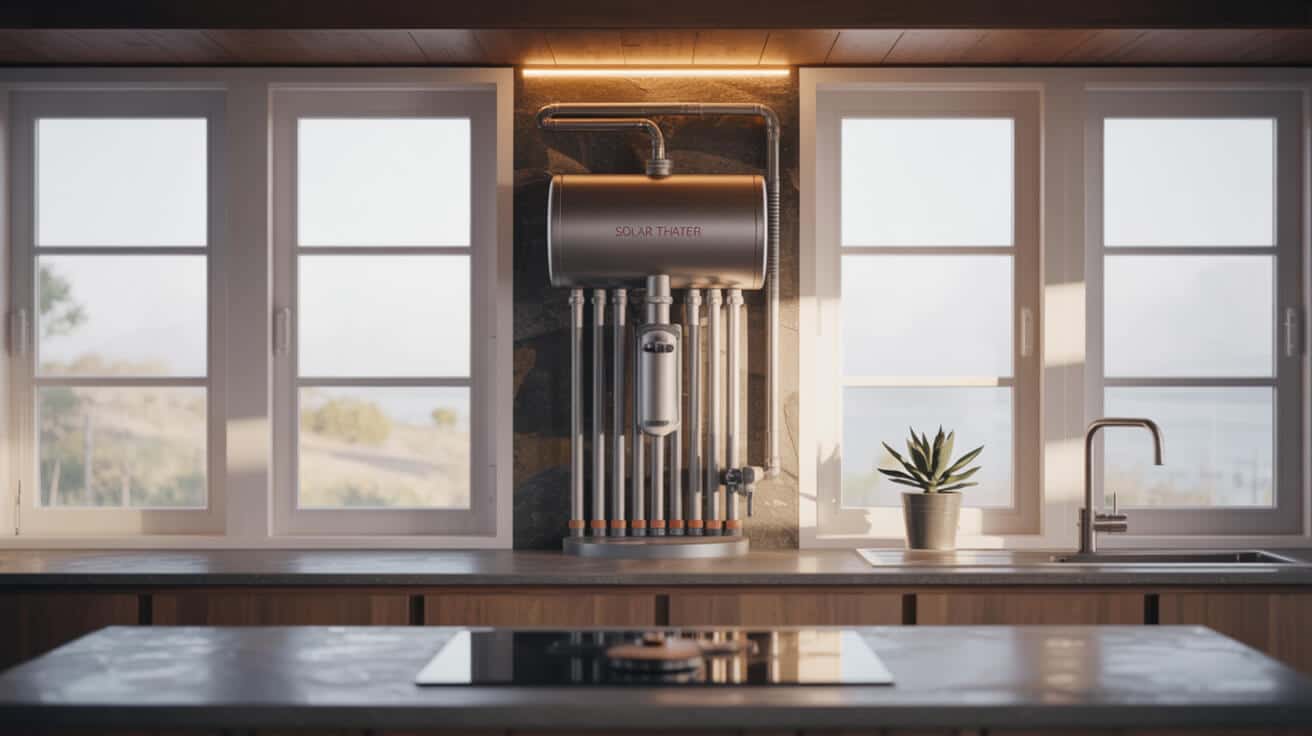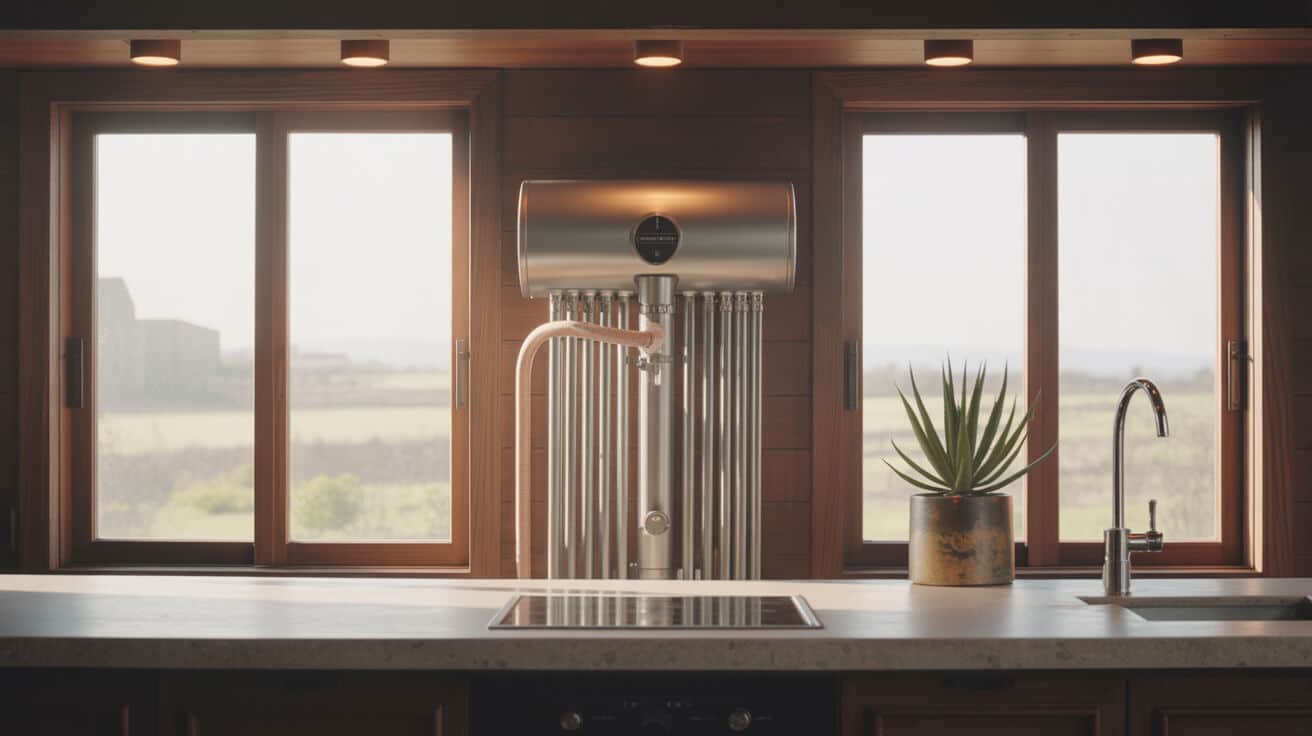A solar thermal hot water system transforms sunlight into usable heat for water provision, typically integrating with conventional plumbing and heating arrangements. These systems include a combination of collectors, storage vessels, fluid circulation networks, and control electronics, managed to ensure optimal year-round performance. Widespread adoption is driven by reductions in fossil fuel dependence, improved energy ratings, regulatory incentives, and the ability to serve a wide variety of property types—from domestic homes to large commercial facilities.
Deployment across diverse building types is accelerating due to climate policies, market-driven incentives, and increased owner awareness. Plumbers 4U’s engineers frequently deliver these solutions as part of high-performance retrofit and new-build upgrades, reinforcing the dual value of cost-efficiency and environmental stewardship for your property or organisation.
Etymology or name origin
The phrase “solar thermal hot water system” unites technical terms describing both origin and process: “solar” derives from the Latin solaris (of the sun), “thermal” references heat energy, and “hot water system” labels the interconnected array that makes heated water reliably available in a property. This terminology has gained consistent international usage as the prominence of renewable energy within the plumbing and heating sector has grown.
Overview / context
Solar-based water heating plays a pivotal role in global efforts to reduce greenhouse gas emissions, cut operational costs, and raise building standards. Within the scope of plumbing and heating, it represents a practical interface between mechanical engineering, sustainable design, and operational management for your property or building portfolio.
Integration into typical building services is straightforward. The system encompasses dedicated roof- or ground-mounted collectors, a fluid-based circulation network for heat transfer, and a storage cylinder—usually vented or unvented, twin-coil or single-coil. Sophisticated controls modulate system activity to deliver consistent hot water while ensuring user safety and energy optimization. Flexible in application, these systems can be tailored to single dwellings, multiple occupancy buildings, commercial plant rooms, swimming pools, and even process water in industrial settings.
Plumbers 4U adapts the system’s design to your specification, property archetype, and future-proofing requirements, reflecting the growing expectation for buildings to achieve and maintain high levels of compliance and efficiency.
History
Early developments
Primitive solar water heating traces back to ancient baths, but systematic collection for domestic use first emerged in the late 1800s, with black-tanked, rooftop batch designs in the United States and Mediterranean. Early 20th-century evolution included glass-covered panels and improved plumbing integration, yet widespread uptake lagged due to the cost and convenience of fossil fuels.
Industrial emergence
The second half of the 20th century saw rapid development in flat plate collector design, storage insulation, corrosion-resistant materials, and control logic. Introduction of pressurised, closed-loop transfer circuits enabled reliable operation in cooler climates. Commercialization spread to Europe, Australia, and Asia as governments recognised the role of solar heat in national energy strategies.
Contemporary evolution
Present systems feature evacuated tube collectors with improved optical efficiency and vacuum insulation, sophisticated digital control platforms, and smart integration with home automation. In the United Kingdom, regulatory drivers such as the Building Regulations (Part L and G3) and the Energy Performance Certificate (EPC) fuel adoption, while incentives like the Boiler Upgrade Scheme (BUS) and Energy Company Obligation (ECO4) reduce owner payback periods and ensure widespread access.

Concept / description
Solar thermal hot water systems harness the sun’s irradiance to heat water through a controlled and insulated pathway. Their design and operation reflect both underlying physical principles and regulatory compliance standards.
Core principles
- Solar collectors: , mounted to maximise annual solar gain, use selective absorbers to translate incident sunlight into heat energy.
- Transfer fluids: , typically a water-glycol mixture, circulate through the collectors, absorbing absorbed thermal energy without freezing or corroding piping.
- Heat exchange: occurs within a coil in a storage cylinder, enabling safe, separated, and regulated transfer from collector fluid to domestic supply.
- Auxiliary heaters: may supplement supply during periods of limited solar input, managed by field-programmable logic controllers and fail-safe override devices.
- System control: involves a suite of sensors, pumps, valves, and expansion vessels; contemporary controllers offer weather compensation, smart metering, and safety alarms.
Main components
| Component | Description | Variants/Notes |
|---|---|---|
| Collectors | Absorb and transfer solar radiation | Flat plate, evacuated tube, integrated collector-storage |
| Storage cylinder | Holds and dispenses heated domestic water | Vented/unvented, single/twin-coil, preheat tanks |
| circulation pump | Drives transfer fluid through the collector and exchanger | Variable speed for efficiency |
| Heat transfer fluid | Circulates between collectors and cylinder coils | Water-glycol (antifreeze), filtered potable water |
| Control system | Manages pump, sensors, heating priorities, safety logic | Hardwired, programmable, cloud-enabled in advanced units |
| Expansion vessel | Absorbs pressure fluctuations from heat/cool cycles | Sizing per system volume |
| Safety valves & sensors | Maintain pressure/temperature, detect leaks or airlocks | PRV, TPRV, thermostatic mixing valve |
| Insulation | Reduces energy losses in pipework and storage | Compliant to Part L Building Regulations |
System architectures
- Direct (open-loop) systems: Circulate potable water through collectors and the cylinder; suited to mild climates with low freeze risk.
- Indirect (closed-loop) systems: Use a separate heat transfer circuit, protecting vital components from scale, oxidation, or freezing; preferred for the UK and northern Europe.
- Drainback systems: Gravity-emptied collector circuits for overheat and freeze protection.
- Hybrid configurations: Combine solar, boiler, or heat pump sources, with prioritised energy flows controlled by programmable logic.
Functionality / purpose / applications
solar thermal systems serve to supplement or supply the majority of a building’s domestic hot water needs, thereby enhancing energy performance and reducing monetary outlay for you as a property owner or building manager.
Applications as an energy strategy
- Residential sector: Preheat or primary source for hot water in single- and multi-family dwellings.
- Commercial/institutional sector: Serving high-volume demand in hotels, care homes, office blocks, sports/leisure centres, and schools. Plumbers 4U has supplied scalable systems adapted to your business’s occupancy profile, peak demand, or regulatory grade.
- Industrial/process application: Preheating for process water, sanitation, or low-temperature production cycles.
Deployment scenarios
- Retrofit: Seamless addition to existing cylinders and pipework with minimal disruption to your daily routines or tenant comfort.
- New build: Full integration into passive or energy-neutral building concepts, maximising compliance and future scalability.
- Hybridization: Connection with air or ground source heat pumps, high-efficiency gas boilers, or electric immersion for balanced supply.
Outcomes for your property
- Energy and cost savings over projected payback periods.
- Enhanced EPC scores (in the UK).
- Reduced carbon emissions and carbon-tax liabilities.
- Compliance with landlord or business energy efficiency obligations.
Classifications / types / variants
Collector technologies
Flat plate collectors
Flat plate designs offer robust construction and broad compatibility with European and UK roof types. They are more affordable and less fragile than evacuated tube models, featuring efficiency curves that favour higher solar irradiation and non-extreme climates.
Evacuated tube collectors
Evacuated tube technology uses glass cylinders with internal vacuum insulation, achieving excellent cold-weather performance and superior yield-per-area. Higher up-front costs are often offset by elevated savings over the system’s lifetime, making them well-suited to northern properties or highly variable climates.
Integrated collector-storage and drainback
Integrated collector-storage systems combine functional storage with collection in one unit, suitable for climates with year-round warmth but seldom for UK applications. Drainback designs further mitigate the risk of freeze or stagnation by allowing thermal syphon to empty the collector loop as needed.
System configurations
- Open-loop vs closed-loop: Potable water or separate heat-transfer fluid circuits.
- Gravity vs pumped circuit: Passively or actively circulated system, dictated by system scale and height differential.
- Preheat or direct-supply schemes: Whether the solar thermal system “preheats” water before it reaches your primary boiler, or acts as a standalone zone.
Storage formats
- Twin-coil cylinders: One coil dedicated to solar, the other to auxiliary heat. Unvented (G3-compliant) or vented tank designs provide flexibility across your property types.
- Thermal stores: Buffer tanks accommodating multiple simultaneous heat sources, preferred for complex multi-function systems and large apartment blocks.
Auxiliary and control options
Programmable logic controllers, weather-compensated sensors, and thermostatic mixing valves are standard. Advanced smart controls, including cloud-based diagnostics, allow for remote monitoring and enhanced operational optimization.
Systems / tools / methodologies
Sizing and specification tools
- Proprietary and public-domain software calculate annual solar yield based on your roof’s angle, orientation, local solar resources, and planned hot water usage.
- Methods conform to MCS (UK) and equivalent national building codes.
Installation methodologies
Site assessment
- Structural survey of roof (weight limits, fixing options).
- Shading analysis over annual cycle using digital or optical tools.
- Assessment of pipework routes and minimal disruption pathways.
Installation phases
- Collector mounting: Flush to roof/integrated, with wind and weatherproofing.
- Pipework and insulation: Copper or cross-linked plastic, with high-grade insulation to minimise thermal losses.
- Cylinder and control fitment: Alignment of coils, expansion vessel, pressure safety checks.
- Commissioning: Fluid fill, pressure test, control calibration, handover documentation.
Record-keeping
- Completion of benchmark logbook, maintenance schedule, and warranty registration as per MCS and Building Regulations.
Diagnostic and maintenance procedures
- Annual glycol concentration test, pressure reading, and component check.
- Replacement of seals and gaskets at defined intervals to prolong system life.
- Troubleshooting routines for airlocks, pump or sensor failure, limescale, or stagnation.

Stakeholders / entities involved
Property owners and occupiers
Your direct benefit includes decreased utility costs, higher property value, and improved compliance. Landlords remain accountable for system function and service under evolving letting and safety regulations.
Plumbing and heating professionals
Certified installers, typically accredited through MCS and G3, ensure compliant installation, commissioning, and support. Entities like Plumbers 4U act as both design partner and service provider throughout the system life cycle.
Manufacturers and suppliers
Production and distribution networks include recognised brands specialising in collectors, tanks, smart controllers, and safety components. Sourcing from WRAS-approved suppliers and leveraging Plumbers 4U’s relationships improve compliance and warranty outcomes for your projects.
Regulatory, policy, and industry bodies
Accrediting entities—MCS for national scope, WRAS for potable water components, TrustMark for consumer protection, and Building Control for statutory signoff—each play roles in system legitimacy and grant eligibility.
Legal / regulatory / ethical considerations
Building regulations and safety codes
- Part L (energy performance): Enforces minimum standards for energy use and thermal insulation.
- Part G (sanitation, water safety): Limits on hot water delivery temperatures to prevent scalding and mandates anti-legionella design.
- G3 (unvented safety): Rules for unvented cylinder sizing, pressure controls, TPRVs, discharge pipework, and competent installation.
- WRAS approval: All components must comply with the Water Supply (Water Fittings) Regulations, minimising cross-contamination risk and ensuring long-term system hygiene.
Certification and compliance
MCS (Microgeneration Certification Scheme) compliance is essential both for system performance and access to grants. TrustMark offers assurance for homeowners and commercial occupiers.
Grants, incentives, and reporting
Eligibility for schemes such as BUS or ECO4 mandates full system signoff and continuous record-keeping. Improving the building’s EPC rating may be contingent upon solar thermal installation and ongoing service.
Installer and owner responsibilities
Certified installation and annual service ensure ongoing compliance and access to incentives. Your role as the property manager or user is to retain documentation and execute required maintenance intervals, ideally supported by a contracted partner such as Plumbers 4U.
Ethical considerations
Transparent communication on design adjustments, savings forecasts, and grant prospects is encouraged throughout your decision and ownership cycle.
Performance metrics / data / measurements
Efficiency metrics
- Solar fraction: Proportion of annual hot water demand met by solar input (typically 50–70%).
- Collector efficiency coefficients: Factor in cupro-nickel absorbency, glass transmittance, and insulation thickness, verified through MCS certification.
- Annual energy yield: Variable by geography, roof orientation, and usage; estimated via simulation tools.
Comparative analysis
| Parameter | Solar Thermal | Electric Immersion | Heat Pump | Gas Boiler |
|---|---|---|---|---|
| Greenhouse Gas | Zero runtime | High | Low | Medium-High |
| Operating Cost | Low | Medium-High | Low | Medium |
| Maintenance Need | Medium | Low | Medium | Medium |
| System Lifespan | 20+ years | 8–12 years | 12–16 years | 12–18 years |
Monitoring and diagnostics
- Digital controllers: Track system, record temperatures, alarms, and warnings.
- Smart metering (non-IoT): Allows property managers to monitor efficiency and confirm savings, optimising maintenance schedules for your facility or business.
Performance influencers
- Weather and shading: Strong seasonal influence in the UK and northern latitudes.
- System configuration: Nutrient mix, vessel insulation, and fault-free operation maximise delivered savings.
- Servicing discipline: Regular, professional checks maintain reliability over the system lifetime.
Challenges / barriers / limitations
Technical and operational barriers
- Roof suitability, orientation, and available space may preclude optimal collector installation.
- Freeze and scaling risks managed through correct fluid specification and maintenance.
- Installation requires interruption of existing services, necessitating advance planning to minimise disruption.
Market and regulatory barriers
- Grant and compliance schemes evolve, creating a moving target for incentive and documentation requirements.
- Up-front capital investment remains a common objection, balanced by long-term reduced bills and incentive eligibility.
- Limited qualified installer capacity in some regions may elongate project timelines for your organisation.
User and perception barriers
- Concerns regarding roof aesthetics, fear of leaks, or maintenance complexity may deter first-time buyers or property managers.
- System function is weather-dependent and most advantageous as a supplement, rather than replacement, for auxiliary heating.
Impact / influence / legacy
Solar thermal hot water systems enable organisations, property owners, and policymakers to jointly reduce the carbon and financial burden of hot water production. They act as accelerants for innovation in plumbing and heating engineering, fostering new alliances between manufacturers, government, and installation professionals. Routine adoption in residential and non-residential segments sets the stage for further normalisation of renewable infrastructure.
Behavioural changes include increased focus on proactive maintenance, enhanced knowledge transfer from certified professionals, and implementation of scheduled monitoring for performance optimization. The legacy manifests in higher energy standards and broader awareness of your property’s capacity for self-sufficiency and ecological impact.
Future directions, cultural relevance, and design discourse
Continual advancements in collector coating, pipe insulation, and system intelligence promise incremental gains in both reliability and output. Anticipated updates to energy and building codes—coupled with government mandates on carbon neutrality—signal a future in which solar thermal technology will find broader application and acceptance.
Culturally, these systems represent a transition toward conscious consumption and autonomy. User-driven interface design, architectural integration with modern and heritage buildings, and further hybridization with other energy systems are on the horizon. Professional discourse increasingly centres on the optimization of grant mechanisms, lifecycle performance analysis, and pathways for community-scale implementation, ensuring relevance for all stakeholders as environmental responsibility moves from optional to expected within the property sector.

